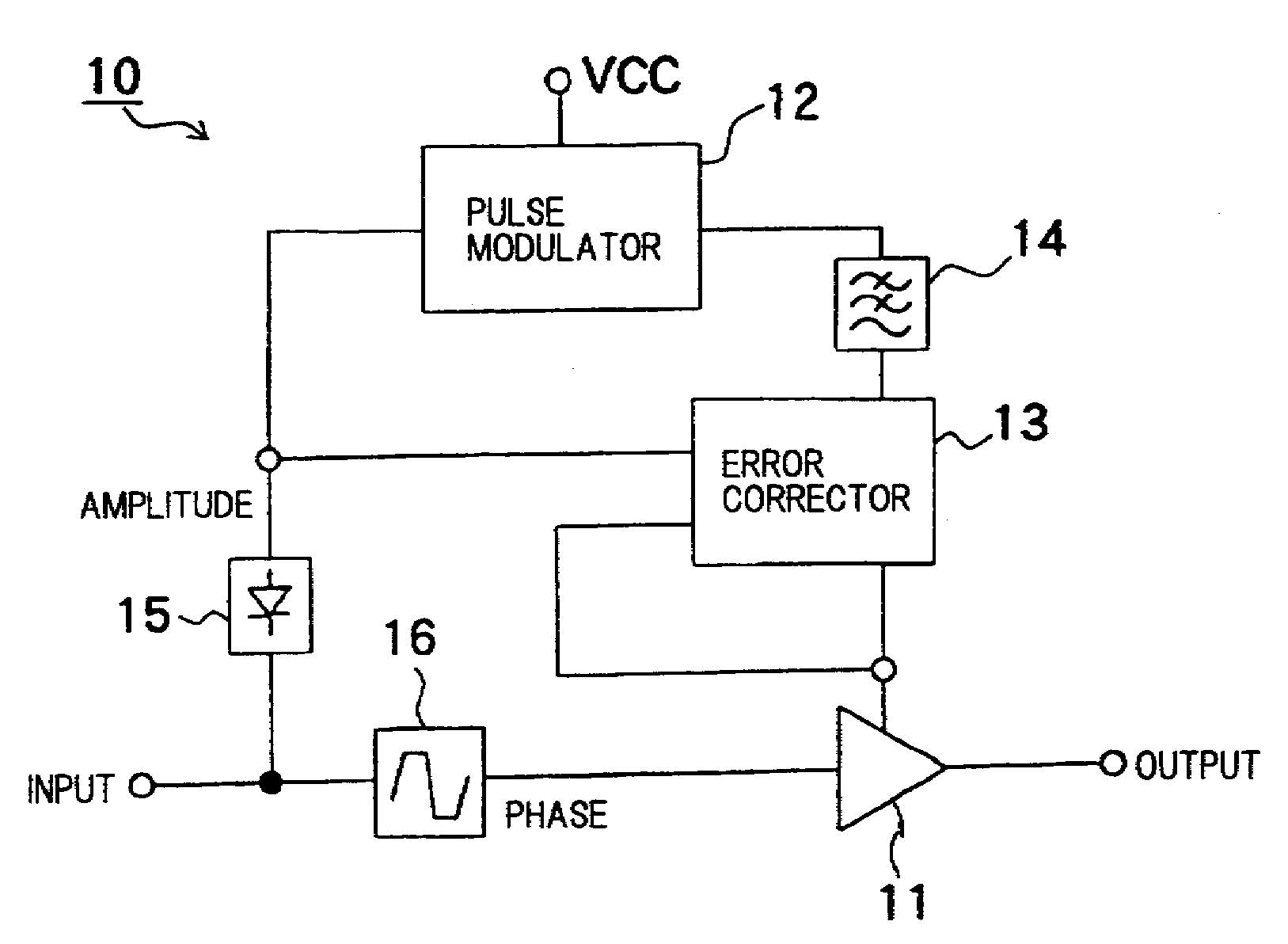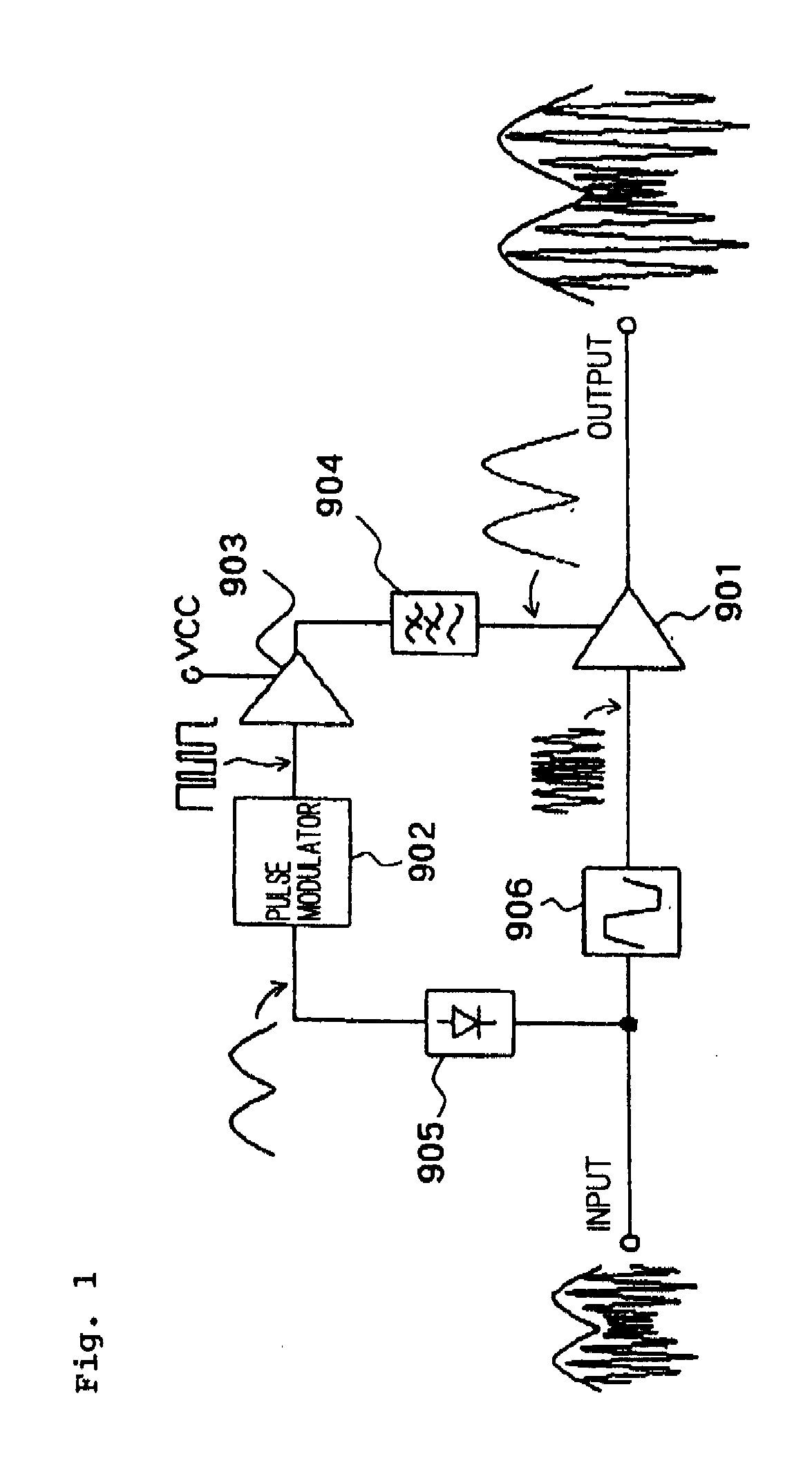Amplifying apparatus
a technology of amplifying apparatus and amplifier, which is applied in the direction of phase-modulated carrier system, modulation, gain control, etc., can solve the problems of white quantization noise being the main noise source, the specification of acpr may not be satisfied, and the noise level of an amplifying apparatus using the eer method or the et method is higher than that of a normal linear amplifying apparatus. achieve high quality and high frequency high
- Summary
- Abstract
- Description
- Claims
- Application Information
AI Technical Summary
Benefits of technology
Problems solved by technology
Method used
Image
Examples
first exemplary embodiment
[0057]FIG. 3 is a block diagram illustrating a configuration of a high frequency amplifying apparatus according to a first exemplary embodiment. Referring to FIG. 3, high frequency amplifying apparatus 10 is an EER amplifier including RF amplifier 11, first pulse modulator 12, error corrector 13, low-pass filter 14, envelope detector 15, and limiter 16.
[0058]A digital-modulated high frequency input analog signal which is inputted to high frequency amplifying apparatus 10 is caused to branch to two signals. One signal of the two signals is inputted to envelope detector 15, and the other signal is inputted to limiter 16.
[0059]Envelope detector 15 eliminates a carrier frequency component from the inputted signal, and extracts an amplitude component (envelope). An output of envelope detector 5 is inputted to pulse modulator 2 and error corrector 13.
[0060]First pulse modulator 12 pulse-modulates and amplifies a signal from envelope detector 15 to output the signal to low-pass filter 14. ...
second exemplary embodiment
[0108]In high frequency amplifying apparatus 10 of the first exemplary embodiment illustrated in FIG. 3, error corrector 13 uses the amplitude signal which is not mixed with the phase signal from limiter 16 and which is provided from low-pass filter 14 to correct an error. However, the present invention is not limited to this configuration. As another configuration example, error corrector 13 may extract the amplitude component from a high frequency output signal which is obtained by mixing the amplitude signal from low-pass filter 14 and the phase signal from limiter 16 in RF amplifier 11, and may use the amplitude component to correct the error.
[0109]FIG. 9 is a block diagram illustrating a configuration of a high frequency amplifying apparatus according to a second exemplary embodiment. Referring to FIG. 9, high frequency amplifying apparatus 20 includes RF amplifier 11, first pulse modulator 12, error corrector 13, low-pass filter 14, envelope detector 15, limiter 16, and envelo...
third exemplary embodiment
[0121]In the first exemplary embodiment, a configuration is described in which the amplitude component is extracted by envelope detector 15, and the phase component is extracted by limiter 16 from the high frequency input signal, however, the present invention is not limited to this configuration. If a base band section is configured to be able to output the amplitude signal and the phase signal, the high frequency amplifying apparatus may directly use those signals. If so, extraction of the amplitude signal by envelope detector 15 and extraction of the phase signal from the high frequency input signal, become unnecessary, so that the size of circuit is reduced.
[0122]FIG. 11 is a block diagram illustrating a configuration of a high frequency amplifying apparatus according to a third exemplary embodiment. Referring to FIG. 11, high frequency amplifying apparatus 30 includes RF amplifier 11, first pulse modulator 12, error corrector 13, low-pass filter 14, and frequency converter 19. ...
PUM
 Login to View More
Login to View More Abstract
Description
Claims
Application Information
 Login to View More
Login to View More - R&D
- Intellectual Property
- Life Sciences
- Materials
- Tech Scout
- Unparalleled Data Quality
- Higher Quality Content
- 60% Fewer Hallucinations
Browse by: Latest US Patents, China's latest patents, Technical Efficacy Thesaurus, Application Domain, Technology Topic, Popular Technical Reports.
© 2025 PatSnap. All rights reserved.Legal|Privacy policy|Modern Slavery Act Transparency Statement|Sitemap|About US| Contact US: help@patsnap.com



